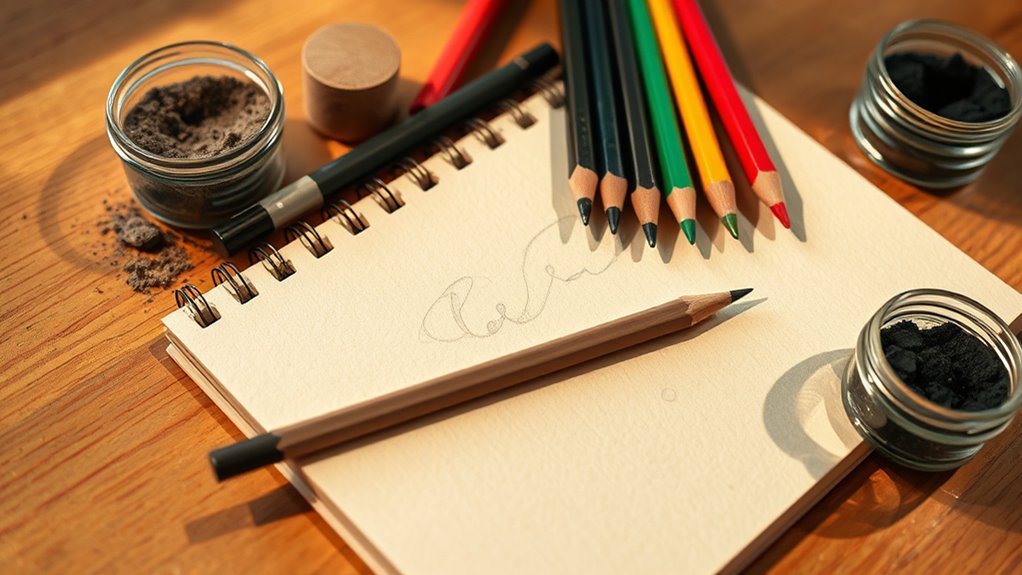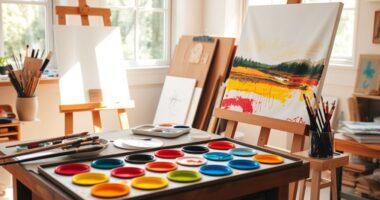To start sketching, gather essential supplies like quality pencils with various hardness levels (2B to 4H), erasers including kneaded and rubber types, and a sturdy sketchbook suited to your medium. Add blending tools like tortillons, sharpeners, and rulers for accuracy. Consider special papers for different effects, and keep tools clean and organized to improve your work. Exploring more tips will help you build a strong creative toolkit for your projects.
Key Takeaways
- A range of pencils with various hardness levels (e.g., 2H to 6B) for detailed work and shading.
- Quality sketchbook or paper suited to your chosen medium, such as smooth or textured surfaces.
- Erasers including rubber and kneaded types for corrections, lifting, and shaping.
- Blending tools like stumps, tortillons, or soft pastels to create smooth shading effects.
- Basic accessories such as sharpeners, rulers, and portable palettes to organize and enhance your sketching process.
Pencils and Erasers
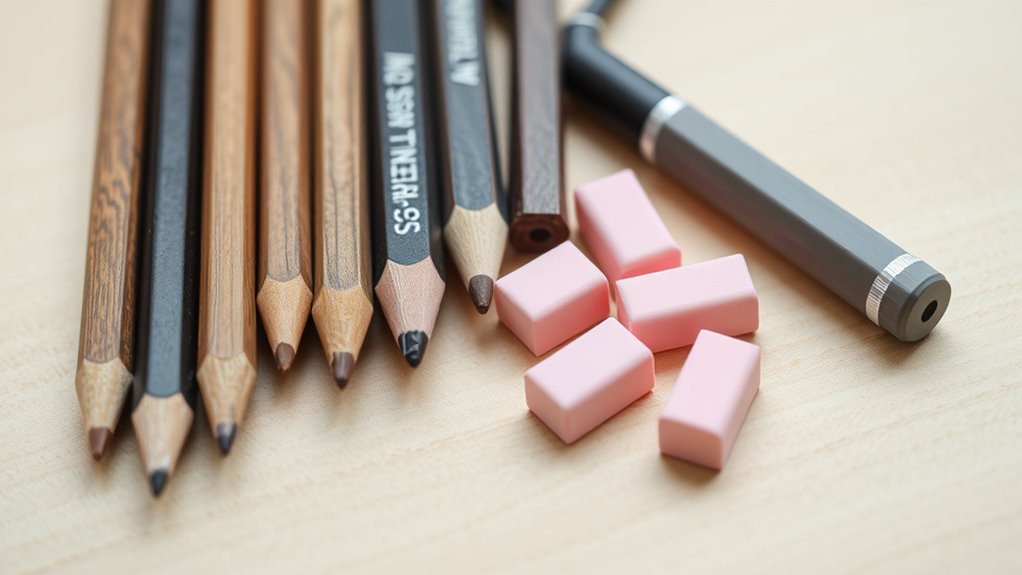
A good set of pencils and erasers is essential for any sketching kit. When choosing pencils, consider pencil hardness; softer leads like 2B or 4B create darker lines, ideal for shading, while harder leads like 2H or 4H produce lighter, precise lines for details. Having a range of hardness levels allows you to develop depth and contrast in your sketches. Understanding pencil types can help you select the right tools for your style and projects. Eraser types also matter—rubber erasers are great for clean corrections, while kneaded erasers lift graphite gently and can be shaped for specific areas. Precision is key, so select erasers that suit your style. High-quality tools can significantly improve your drawing experience. Together, the right pencil hardness and eraser types give you control and flexibility, helping you achieve the desired effects and maintain a clean workspace as you sketch.
Sketchbooks and Paper Types

Choosing the right sketchbook and paper type can considerably impact your drawing results. When selecting a sketchbook, consider sizes that fit your workspace and style—small for quick sketches, larger for detailed work. The paper weight options are equally important; lighter paper (around 70-100 gsm) works for quick studies, while heavier paper (150 gsm and above) handles ink, watercolor, and mixed media without bleeding or warping. Look for smooth surfaces if you prefer fine lines and detailed shading, or textured paper for expressive, loose sketches. Your choice depends on your preferred medium and technique. Having the appropriate sketchbook and paper type guarantees your artwork stays true to your vision, making the entire sketching process more enjoyable and productive.
Drawing Tools and Accessories
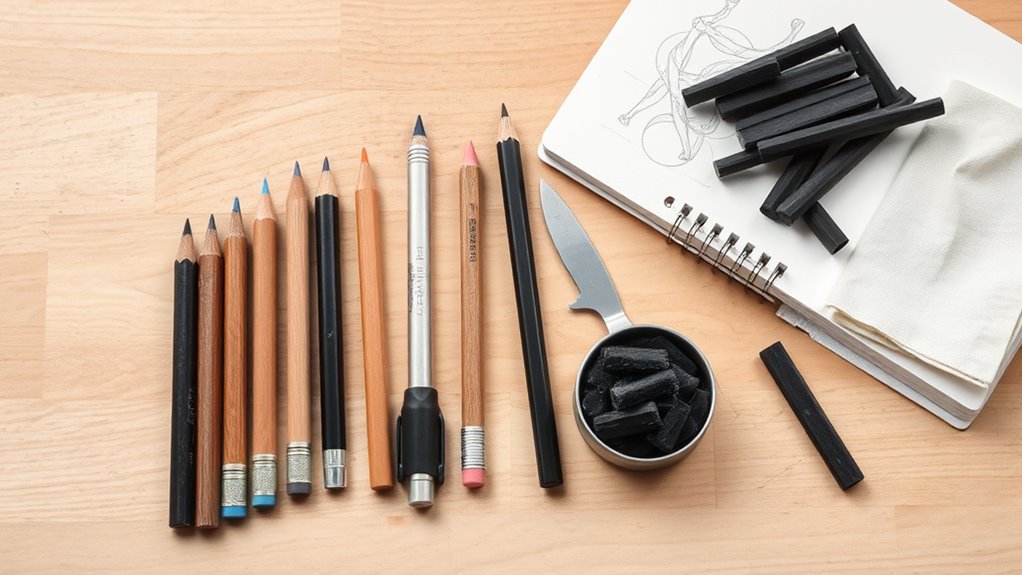
Your sketching toolkit starts with the right pencils and erasers to capture your ideas accurately. Choosing the appropriate drawing paper types can enhance your work, depending on your style. Don’t forget to explore accessories and extras that can improve your process and add versatility to your sketches. Incorporating artistic expression techniques can help you overcome creative barriers and unlock your full potential. Additionally, understanding machine learning algorithms can inspire innovative approaches to your art, such as digital enhancements and intelligent tools. With the rise of AI security measures, digital art platforms are increasingly implementing safeguards to protect creators’ work from unauthorized use. Utilizing automotive scan tools can also aid digital artists in troubleshooting and maintaining their hardware setups effectively.
Pencils and Erasers
Having the right pencils and erasers is essential for achieving the desired results in your sketches. Choosing the correct pencil grip techniques helps control your lines and shading, while understanding eraser types allows you to refine details or lighten areas effectively. Different pencils, from hard (H) to soft (B), suit various sketching needs, and erasers come in many forms, like kneaded or precision tip, for specific tasks. Here’s a quick reference:
| Pencil Type | Grip Technique | Eraser Type |
|---|---|---|
| H to 6B | Firm grip | Kneaded |
| 2H to HB | Relaxed grip | Vinyl |
| 4B to 8B | Light grip | Precision tip |
| Extra soft | Delicate grip | Electric |
Master these tools, and your sketches will improve considerably. Additionally, experimenting with eraser techniques can help you achieve softer shading and better highlights. Understanding pencil grades allows artists to select the appropriate hardness for different shading effects, enhancing the depth and realism of sketches. Furthermore, knowing about eraser types can help you choose the best tool for specific shading or correction needs, making your drawing process more efficient and precise. Exploring color blending techniques can also add a new dimension to your sketches by creating smoother transitions and richer textures.
Drawing Paper Types
Selecting the right drawing paper can substantially impact your sketching results. If you’re working with wet media like watercolors, watercolor paper is essential because it absorbs moisture without warping or tearing. It comes in various textures, from smooth to rough, so choose based on your desired effect. For ink or marker sketches, Bristol board offers a sturdy, smooth surface that allows for crisp lines and detailed work. It’s heavyweight and resistant to bleed-through, making it ideal for precision. When selecting paper, consider your medium and style—using the appropriate type ensures your artwork looks professional and lasts longer. Keep in mind that the right paper can elevate your sketching experience, helping you achieve better control and clarity in your drawings.
Accessories and Extras
Choosing the right drawing tools and accessories can considerably enhance your sketching process. Accessories like blending stumps, erasers, and sharpeners help you refine details and create smooth progressions. If you work with traditional media, color mixing tools such as palettes or mixing trays make blending colors easier. Additionally, exploring sound healing science can inspire a more mindful approach to your art sessions, promoting focus and relaxation. Incorporating ergonomic tools like stylus grips can improve comfort during extended digital sketching sessions. For digital sketching, accessories like stylus grips and screen protectors improve comfort and precision. Additional extras like rulers or stencils can assist with accurate shapes and perspectives. These tools streamline your workflow and help you achieve your desired effects faster. Whether you’re blending colors on paper or adjusting digital layers, having the right accessories guarantees your sketches look polished and professional. Investing in quality extras keeps your creativity flowing seamlessly. Understanding the importance of tax implications can also inspire you to choose tools that optimize your workspace and workflow.
Blending and Shading Materials

Choosing the right blending tools can make a big difference in your shading. Once you have your tools, applying effective shading techniques will help your sketches look more realistic. Experimenting with different methods will improve your overall drawing skills. Additionally, understanding the various cookie categories can help you customize your browsing and protect your privacy while researching art techniques online. Being aware of local legal resources can also be beneficial if you encounter any issues related to intellectual property or licensing of your artwork. Moreover, exploring creative communities can provide valuable feedback and inspiration to refine your sketching techniques. Recognizing the importance of emotional support can also help you stay motivated and confident as you develop your artistic abilities.
Blending Tools Selection
When it comes to blending and shading, the right tools can make all the difference in achieving smooth, realistic gradients. If you’re working digitally, explore digital blending tools like smudge brushes and digital pencils, which allow precise control and easy adjustments. For traditional media, pastel tools are excellent for soft blending, offering a creamy texture that helps create seamless transitions. Blending stumps and tortillons are also versatile options for smudging graphite or charcoal smoothly. Consider the type of material you’re using—soft pastels for rich, velvety shading or harder tools for sharper lines. Using the proper filtering techniques can also help protect your work from dust and debris, ensuring a clean finish. Additionally, selecting the appropriate blending tools based on your medium can significantly impact the overall effect of your shading. Proper material selection can enhance the texture and depth of your artwork, making your shading look more natural and refined. Understanding the Honda Tuning principles can also inspire creative ways to approach your shading techniques, adding a layer of personalization to your artwork. Selecting the appropriate blending tools enhances your control and guarantees your shading looks natural and refined, whether you’re working digitally or with traditional supplies.
Shading Techniques Tips
Have you ever wondered how to achieve realistic shading in your sketches? The key is understanding how your light source affects shadow softness. When the light is direct and intense, shadows tend to be sharper and more defined; softer light creates more gradual transitions. Use blending tools like tortillons or tissue for smooth gradients, but be mindful of shadow softness—blending too much can flatten your drawing. For sharper shadows, keep some areas less blended or use a harder pencil. Remember, the placement of shadows depends on the light source, so observe how light falls on objects. Mastering these shading techniques helps create depth and realism, making your sketches more convincing and dynamic. Additionally, understanding light source effects can greatly improve the accuracy of your shading. Recognizing how different shading materials respond to various techniques allows artists to better control their shadowing and achieve desired textures and effects. Being aware of automation in business can also inspire new approaches to streamline your art workflow and focus more on creative shading techniques.
Portable Drawing Essentials

Traveling light is essential for sketching on the go, and having the right portable drawing essentials makes all the difference. A good portable sketching pack keeps your supplies organized and easily accessible, so you can focus on your creativity without hassle. Look for lightweight carrying cases that won’t weigh you down but still protect your pencils, pens, and small accessories. Compact sketchbooks are a must, fitting comfortably into your pack while providing enough space for your ideas. Carry a few essential tools like erasers, sharpeners, and a portable palette if you paint. These essentials should be durable and easy to transport, ensuring you’re always ready to capture inspiration wherever you are. Staying organized with portable sketching packs helps you sketch confidently anytime, anywhere. Additionally, choosing a Vetted electric bike conversion kit can make it easier to reach scenic spots or outdoor sketching locations without fatigue. Incorporating sensory toys into your gear can help you stay relaxed and inspired during longer outdoor sessions.
Maintenance and Storage Supplies
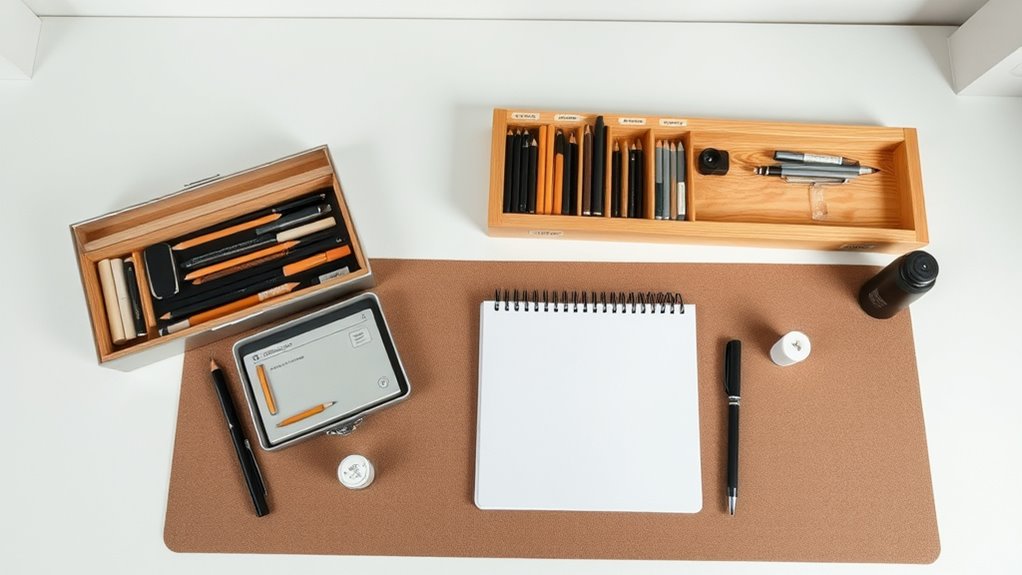
Proper maintenance and storage are essential to keep your sketching supplies in top condition and ready for use. To prolong eraser life, clean them regularly by gently removing debris and avoiding excessive force. Store erasers in a separate compartment to prevent smudging your work. For pencils, sharpen using proper techniques: rotate the pencil steadily and avoid over-sharpening to preserve lead. Keep your tools organized in a dedicated box or drawer. Use the table below for quick tips:
| Maintenance Tips | Storage Solutions |
|---|---|
| Clean erasers often | Use compartments for pencils |
| Sharpen pencils carefully | Store in dry, cool place |
| Avoid dropping supplies | Keep away from moisture |
| Replace worn erasers | Label storage for easy access |
Keeping supplies well-maintained guarantees smooth sketching sessions.
Frequently Asked Questions
What Are the Best Sketching Supplies for Beginners?
When starting out, you wanna focus on basic sketching supplies that fuel your artistic inspiration and help you learn sketching techniques. Grab a good quality pencil, an eraser, and sketchbook to practice comfortably. You can also add some colored pencils or pens for variety. These essentials will support your creativity and make it easier to develop your skills, letting you explore different styles and ideas as you grow.
How Do I Choose the Right Paper Texture?
When choosing the right paper texture, consider your preferred drawing style. You want to pay attention to the paper grain and surface finish. A smooth surface finish works well for detailed work and ink, while a rougher texture with more pronounced grain suits charcoal or pastel. Test different papers to see how your pencil or medium interacts, ensuring the surface enhances your technique and gives you the desired results.
Which Drawing Tools Are Essential for Detailed Work?
For detailed work, you need fine-tipped pencils like 2H or 4H for precision. Use proper pencil grip techniques to maintain control and accuracy, especially for intricate lines. Keep a kneaded eraser handy for subtle erasing methods, allowing you to correct mistakes without damaging your paper. These tools help you achieve clean, precise details, making your sketches more refined and professional.
How Do I Prevent My Pencils From Breaking?
To prevent your pencils from breaking, focus on improving pencil durability and using break prevention techniques. Always hold your pencil gently, especially when applying pressure, and avoid over-sharpening it. Use a sharpener with a gentle touch or a craft knife for precise sharpening. Store your pencils properly, avoiding dropping them or exposing them to extreme temperatures. These simple steps help maintain your pencils’ integrity and guarantee smooth, uninterrupted sketching sessions.
What Are Some Eco-Friendly Sketching Materials?
You’re asking about eco-friendly sketching materials, so let’s explore! Imagine wielding sustainable ink options that flow like a gentle river, and sketch in recycled sketchbooks that breathe new life into each page. Choosing bamboo pencils or plant-based erasers can make your art more planet-friendly. Every stroke becomes a statement, showing that you care for the earth while creating masterpieces—making your art as green as it is beautiful.
Conclusion
With the right supplies tucked away, you’re all set to explore your artistic journey. Think of these essentials as gentle companions guiding your creativity, helping your ideas flow effortlessly onto the page. As you nurture your skills, remember that every tool has its moment to shine—embrace each one with patience and curiosity. Soon, your sketchbook will become a treasured space where your imagination blossoms, quietly revealing the art within you.
